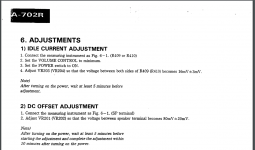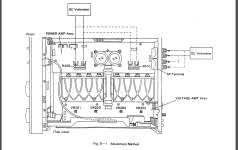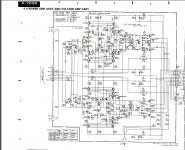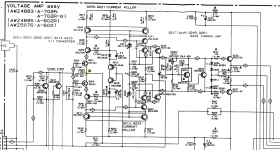Hi, I own a Pioneer A-702R and it doesn't sound like it used to. Measured DC offset it was 140mV, tested it today it's 110mV. After a half hour it's 85mV on left channel and 95mV on right channel...
In the service manual they recommend 80mV +- 20mV.
Should I " tweak " it to achieve less DC voltage ?
Here are two screen shoots from the manual..
In the service manual they recommend 80mV +- 20mV.
Should I " tweak " it to achieve less DC voltage ?
Here are two screen shoots from the manual..
Attachments
The DC offset has to be zero. It should probably read 'adjust for 0.00 volts -/+20mv'.
You should have no speakers attached for doing the idle current adjustment because any DC offset will skew the reading as the voltage will add/subtract from the current in the emitter resistors as current flows into/out of the speaker.
Its also normal for the idle current to wander a bit as it warms up.
Just set offset to zero, then recheck the idle current.
You should have no speakers attached for doing the idle current adjustment because any DC offset will skew the reading as the voltage will add/subtract from the current in the emitter resistors as current flows into/out of the speaker.
Its also normal for the idle current to wander a bit as it warms up.
Just set offset to zero, then recheck the idle current.
This is not the first amplifier, where recommended offset value is not the zero one. Pioneer M-22 has got this kind of recommendation as well.
In both cases, there is particular time-frame specified for adjustment (e.g. from 5 to 10 minutes after power on), so I suppose, it is assumed that the offset will continue drifting towards zero as far as the power amp continues warming up, reaching it after some time.
In both cases, there is particular time-frame specified for adjustment (e.g. from 5 to 10 minutes after power on), so I suppose, it is assumed that the offset will continue drifting towards zero as far as the power amp continues warming up, reaching it after some time.
Now, I got 1mV on the left and 2.4mV on the right !! after 5 mins after power on.
After two hours of listening , i measured ( without speakers ) 12mV and 14mV ..i dont know but it's kinda fluctuating... Turned off the amp for curiosty , 7mV and 8mV after a time it rises to 17mV - 15 mV .. But i think i let it like this.. It would be awesome tho to keep it at 2mV ,1mV like I did before it " self changed ".
Tho , it is better than it was ( 150+ mV on both channels )
The vocals / highs are clearer more crisp , not by much tho .
Also, I have read on a german forum ( used google site translate , LOL ) and someone got the same " issue " when the DC offset doesnt stay and changes all the time.. but far more badly than mine.
Also I dont undersant why to make the " tweaks "after 5 mins of power up ( so the amp warms ) but why within 10 minutes ?. I've read another post on a forum , old post , and someone said to wait 1 -2 hours everything unpluged and after that " tweak " the pots.
Thanks guys , Cheers . Bruno
After two hours of listening , i measured ( without speakers ) 12mV and 14mV ..i dont know but it's kinda fluctuating... Turned off the amp for curiosty , 7mV and 8mV after a time it rises to 17mV - 15 mV .. But i think i let it like this.. It would be awesome tho to keep it at 2mV ,1mV like I did before it " self changed ".
Tho , it is better than it was ( 150+ mV on both channels )
The vocals / highs are clearer more crisp , not by much tho .
Also, I have read on a german forum ( used google site translate , LOL ) and someone got the same " issue " when the DC offset doesnt stay and changes all the time.. but far more badly than mine.
Also I dont undersant why to make the " tweaks "after 5 mins of power up ( so the amp warms ) but why within 10 minutes ?. I've read another post on a forum , old post , and someone said to wait 1 -2 hours everything unpluged and after that " tweak " the pots.
Thanks guys , Cheers . Bruno
If the offset voltage drifts by more than 10 or 20 miliivolts each way then it must be said the amp isn't particularly well designed in that department.
You just have to make the best of a bad situation and set it for near zero when the amp is being used as you normally would. Put the cover on, let it play normally for 20 to 30 minutes and then measure and record the offset noting polarity. Now take the top off and adjust whatever the offset has now drifted to by the required amount to give zero.
You just have to make the best of a bad situation and set it for near zero when the amp is being used as you normally would. Put the cover on, let it play normally for 20 to 30 minutes and then measure and record the offset noting polarity. Now take the top off and adjust whatever the offset has now drifted to by the required amount to give zero.
A cool CFA front-end 
This arrangement of the feedback network with no electrolytic capacitor to ground was a deliberate approach, used by Pioneer engineers at that time. It may be arguable, but the idea was - higher sound quality for the price of lower offset stability.
As I mentioned earlier, M-22 has got the similar offset recommendation in the service manual, having the same NFB network approach (although, this one is VFA) - no capacitor to ground and same kind of offset fluctuations.
So - as mentioned earlier - just set it as close as possible to zero after some time of normal listening (say, half an hour) and accept certain fluctuations as normal by design
This arrangement of the feedback network with no electrolytic capacitor to ground was a deliberate approach, used by Pioneer engineers at that time. It may be arguable, but the idea was - higher sound quality for the price of lower offset stability.
As I mentioned earlier, M-22 has got the similar offset recommendation in the service manual, having the same NFB network approach (although, this one is VFA) - no capacitor to ground and same kind of offset fluctuations.
So - as mentioned earlier - just set it as close as possible to zero after some time of normal listening (say, half an hour) and accept certain fluctuations as normal by design
Who knows. They have to come up with a 'one size fits all' method that is quick for service departments.
If they know that the offset of a hot amp that has been set to zero will be +127 millivolts at initial switch on at room temperature, then they will say 'set the DC offset to +127 millivolts within say 1 minute of switching on when the amp is cold.
Is it good design ?... answers on a postcard
If they know that the offset of a hot amp that has been set to zero will be +127 millivolts at initial switch on at room temperature, then they will say 'set the DC offset to +127 millivolts within say 1 minute of switching on when the amp is cold.
Is it good design ?... answers on a postcard
Yes, I also think it's been done for the sake of "standardized" servicing procedure - short enough.
On the other hand, I don't see too much trouble in having an electrolytic in the feedback network - with the modern high - quality (including non-polarized) capacitors available I don't see any practical quality degradation (of course, until electrolytics dry out over the time). I mean - either use the servo and don't use the cap or don't use the servo and use the cap. Looks like in the middle of 70's, Pioneer engineers thought the other way round.
On the other hand, I don't see too much trouble in having an electrolytic in the feedback network - with the modern high - quality (including non-polarized) capacitors available I don't see any practical quality degradation (of course, until electrolytics dry out over the time). I mean - either use the servo and don't use the cap or don't use the servo and use the cap. Looks like in the middle of 70's, Pioneer engineers thought the other way round.
- Status
- This old topic is closed. If you want to reopen this topic, contact a moderator using the "Report Post" button.
- Home
- Amplifiers
- Solid State
- Pioneer amp problem



